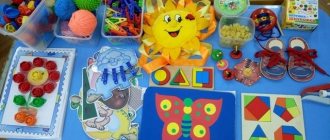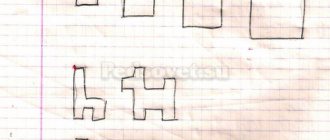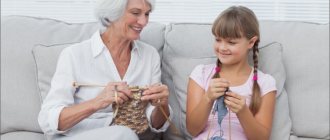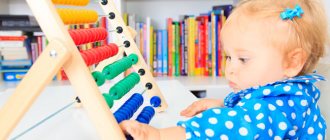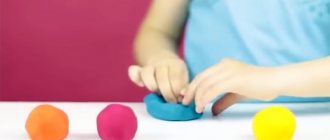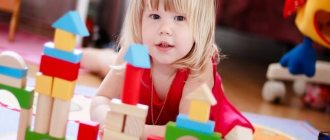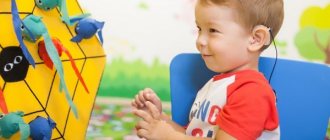The formation and development of functional asymmetry of the hemispheres begins to occur from an early age under the influence of a complex of biological and sociocultural factors. At the same time, the innate prerequisites for the development of one or another type of asymmetry are only prerequisites, and the asymmetry itself is largely formed in the process of individual development under the influence of social contacts. Functional asymmetry of the hemispheres is expressed in the difference in the distribution of neuropsychic functions between the right and left hemispheres.
Functional asymmetry of the hemispheres is one of the reasons for the existence of a certain structure of the psyche. Associated with it are such psychological oppositions as concrete-figurative and abstract-logical thinking, flexibility and rigidity, etc. The varying degrees of expression of these mental properties, already largely represented in a six-year-old child, forms a tendency to preferentially rely on the “left hemisphere” ", "right-hemisphere" or "equal-hemisphere" types of thinking.
Left hemisphere type. The left hemisphere operates with words, conventional signs, symbols; responsible for invoice, letter; provides the ability to analyze, abstract, conceptual and two-dimensional thinking. Information received in the left hemisphere is processed sequentially, linearly, slowly. The dominance of the left hemisphere determines the tendency to abstraction and generalization, the verbal-logical nature of cognitive processes, verbal, theoretical intelligence.
For successful educational activities, the following conditions must be met: an abstract linear style of presenting information, analysis of details, repeated repetition of material, silence in the lesson, the ability to work alone, closed questions, timeless assignments. Such children are characterized by a high need for mental activity.
Right hemisphere type. The right hemisphere operates with images of real objects and is responsible for orientation in space and the perception of spatial relationships. Provides synthetic brain activity; visual-figurative, three-dimensional thinking associated with a holistic representation of the situation and the changes in it that are desirable to obtain. Information received in the right hemisphere is processed quickly. The dominance of the right hemisphere determines the presence of non-verbal, practical intelligence, the ability to draw and perceive the harmony of shapes and colors, an ear for music, artistry, and success in sports.
Conditions necessary for successful learning activities: creative tasks tied to the context, the opportunity to experiment, speech rhythm, group work, synthesis of new material, open-ended questions, social significance of the activity.
Equal hemisphere type. There is no pronounced dominance of one of the hemispheres. This ensures their synchronous activity in choosing a thinking strategy.
School teaching methods are focused mainly on the development of the left hemisphere and do not take into account the presence of different types of development of functional asymmetry of the hemispheres, as well as the difference between boys and girls in the rate of development of the left hemisphere. Therefore, left-hemisphere and equal-hemisphere girls find themselves in the best conditions, while right-hemisphere boys find themselves in the most disadvantageous position.
Currently, the number of children with reduced activity of the left hemisphere is growing. Such children exhibit an inability to assimilate new material, an inability to read and write adequately, and rearrangement of words, signs, signs, and phenomena. Sometimes they are “blind” to entire phrases. The described condition is called “dyslexia,” which translated from Greek means “denial of a word.” With dyslexia, the ability to verbalize spatial representations suffers, immaturity of visual and graphic skills, and weakness of verbal and logical thinking are revealed. The tasks that are most difficult for children with damage to the right hemisphere (constructive, orientation in the schematic representation of spatial relationships, stereognosis) are performed by the majority of children with dyslexia at the level of healthy peers. Left hemisphere failure, both at the functional and morphological level, can be caused by hyperfunction of the right hemisphere, which suppresses the maturation and functional activity of the left hemisphere.
Thus, difficulties in mastering reading in children are associated with a violation of optimal interhemispheric interaction. In older preschoolers and first-graders, at the beginning of the year, the functional superiority of the right hemisphere over the left is noted. At the end of the first year of study, the left hemisphere becomes the leading hemisphere. In this case, reading acquisition occurs without complications. Children who start school with the left hemisphere dominant in terms of activity level develop dyslexia. At the same time, the reading pace is sharply slowed down, but few mistakes are made. The same thing happens with those students who start learning with the right active hemisphere, but there is no change in the activity of the hemispheres by the end of the year (R-type of dyslexia). In this case, the reading pace is relatively high, but there are many errors. Normally, the hemisphere leading in activity should change from right to left within a year. The need for such a reversal of interhemispheric balance is due to the fact that at the initial stage of mastering literacy and graphic symbols, the functionally greatest load falls on the brain systems responsible for the perceptual processing of visual-spatial information (mastering graphemes).
Attempts to exert psychological or disciplinary influence on a student with dyslexia lead to negative consequences. Attempts to speed up the pace of reading acquisition have an unfavorable effect: this almost always worsens reading impairments. Dyslexia is often accompanied by dysgraphia.
In the vast majority of children, dyslexia could be prevented by choosing the optimal method for them (analytical-synthetic or visual) and pace of learning.
To ensure the harmonization of a child’s mental activity, a differentiated system for selecting corrective techniques is necessary in accordance with the type of hemispheric asymmetry. To develop interhemispheric connections, as well as to develop the right and left hemispheres, you can use sets of kinesiological exercises.
Diagnostics of indicators of interhemispheric interaction
Sample N.I. Ozeretsky on the dynamic praxis “Fist-rib-palm”
The child is shown three positions of the hand on the plane of the table, successively replacing each other:
• palm on a plane,
• palm clenched into a fist,
• palm edge-on on the plane of the table,
• again straightened palm on the plane of the table.
The child performs the first test together with an adult, then repeats it from memory 8-10 times. The test is performed first with the right hand, then with the left, then with both hands together.
The task is available for children 6 years and older. This test is sensitive to two types of errors. In the first case, switching from one movement to the next in an automated mode suffers: the child repeats himself or takes long pauses between movements. In the second case, children confuse the sequence of movements or miss some of them.
Fine motor skills
Fine motor skills are the movements of the hand and fingers. It requires focus, attention and precision. For example, writing, drawing, carving, modeling clay, tying shoes, opening doors with keys, grabbing objects, sewing, fastening buttons, braiding hair, working on a computer using a mouse or touch screen.
(c)freepik.com
Developing precision of finger movements and the ability to switch from one movement to another
The child is asked, without looking at his hand, to follow the adult in reproducing various finger poses:
• all fingers are straightened and closed, the palm is turned forward;
• 1st finger is raised up, the rest are collected into a fist;
• the index finger is straightened, the rest are gathered into a fist;
• The 2nd and 3rd fingers are arranged in a V shape;
• The 2nd and 5th fingers are straightened, the rest are gathered into a fist;
• The 2nd and 3rd fingers are crossed, the rest are gathered into a fist;
• The 2nd and 3rd fingers are straightened and arranged in the shape of the letter Y, and the 1st, 4th and 5th fingers are collected into a fist (“bunny”);
• The 1st and 2nd fingers are connected by a ring, the rest are straightened.
Finger games
Finger games will help children:
- make a breakthrough in speech development - improve pronunciation and enrich vocabulary;
- prepare your hand for writing;
- develop attention, patience, the so-called internal brake - the ability to restrain yourself exactly when it is necessary;
- stimulate imagination, show creativity;
- learn to control your body, feel confident in the system of “bodily coordinates,” which will eliminate the possibility of neuroses.
Development of the skill of orientation in the body diagram
1. The child is asked to reproduce the movements performed by an adult sitting opposite him: touch his right ear with his left hand, touch his left eye with his right hand, touch his right eye with his right hand, etc. The task can be used for children 9 years of age and older. Its implementation requires mental spatial reorientation to overcome the tendency to mirror reproduction.
2. Easy orientation. Instructions: “Raise your left hand (you only need to start with your left hand), show your right eye, your left leg.” If the task is completed, then move on to the next one; if not, stop.
3. Instructions: “Grip your right ear with your left hand, your right ear with your right hand, your left ear with your right hand, show your right eye with your left hand.”
Period from 2 to 3 years
The period from 2 to 3 years is an extremely important stage in a child’s life, in particular, in intellectual and cognitive development.
As you know, the organ of thinking, the organ of all mental activity of a person, is the brain. During the development of a child, when the growth of brain cells occurs, their formation, when the nerve fibers quickly grow - the pathways that connect the brain with the sense organs and with the muscles, during the contraction of which various movements occur, the increase in brain mass is of great importance.
The most intensive enlargement of the brain in early and early preschool age indicates that it is at this time that children develop especially quickly. And indeed, how much knowledge and skills a child acquires during the first three years of his life!
He learns to look and listen, talk, grasp objects and act with them, stand, walk, run, jump, go down and up stairs. The child also masters numerous skills - using a spoon, brush, pencil and many other objects.
The child’s memory is enriched with a huge amount of knowledge about colors and sounds, about natural phenomena and objects, the properties of various objects and products of human labor. The baby learns space and time, masters speech, learns to communicate with adults and peers, and learns the basic rules of behavior.
Exercises to develop interhemispheric interaction
The proposed exercises improve mental activity, synchronize the work of the hemispheres, help improve memorization, increase stability of attention, and facilitate the writing process.
The duration of classes depends on age and can range from 5-10 to 20-35 minutes. in a day. You need to exercise daily. The duration of training for one set of exercises is 45–60 days. It is advisable to take a break (two weeks) between complexes.
COMPLEX No. 1
Ring. Alternately and as quickly as possible, you need to move your fingers, connecting the index finger, middle finger, etc. in a ring with the thumb.
The exercise is performed in direct (from the index finger to the little finger) and in the reverse (from the little finger to the index finger) order. First, the exercise is performed with each hand separately, then together.
Fist-rib-palm. Three positions of the hand on the plane of the table successively replace each other. Palm on a plane, palm clenched into a fist, palm with an edge on the plane of the table, straightened palm on the plane of the table; performed first with the right hand, then with the left, then with both hands together. Number of repetitions – 8-10 times. When mastering the program or if there is difficulty in performing it, the child helps himself with commands (“fist-rib-palm”), pronouncing them out loud or silently.
Mirror drawing. Place a blank sheet of paper on the table. Ask the child to take a pencil or felt-tip pen in both hands. Ask him to draw mirror-symmetrical drawings and letters with both hands at the same time (according to the proposed model).
Ear-nose. With your left hand, grab the tip of your nose, and with your right hand, grab the opposite ear. Simultaneously release your ear and nose, clap your hands and change the position of your hands “exactly the opposite.”
COMPLEX No. 2
Instructions: “Knock on the table with a relaxed hand of your right hand, and then with your left hand.”
Instructions: “Leaning on the table with your palms, half bend your elbows. Shake your brushes one by one.”
Instructions: “Connect the end phalanges of the straightened fingers. Using the fingers of your right hand, press firmly on the fingers of your left, then vice versa. Practice these movements for each pair of fingers separately.”
Instructions: “Tap each finger of your right hand on the table, counting “1, 1–2, 1-2-3, etc.”
Instructions: “Fix the forearm of your right hand on the table. Using your index and middle fingers, take a pencil from the table, lift it up and lower it. Do the same with your left hand."
Instructions: “Roll out a small lump of plasticine on the board one at a time with the fingers of your right hand, then your left.”
Instructions: “Rotate the pencil first between the fingers of your right hand, then your left (between the thumb and forefinger; index and middle; middle and ring finger; ring and little finger; then in the opposite direction).”
Instructions: “On the command “Ear!”, grab your ear, on the command “Nose!”, grab your nose.” The adult not only gives these commands, but also performs the movements together with the child, sometimes making intentional mistakes and provoking him to make incorrect movements.
COMPLEX No. 3
Instructions: “Standing, lower your arms, take a quick breath, pulling your hands to your armpits, palms up. Then, exhaling slowly, lower your arms along your body, palms down.”
Instructions: “Standing, make several strong swings of your arms, spreading them to the sides. Close your eyes and imagine that you are flying, flapping your wings.”
Instructions: “Run around the room, wave your arms and shout loudly. On command, stop and relax.” The exercise can be performed while sitting or lying on the floor, swinging your arms and legs.
Instructions: “Press your palm to the surface of the table. First in order, and then randomly raise your fingers one at a time and call them.”
Instructions: “Get on all fours and crawl without touching the objects placed on the floor. Cross your arms."
Instructions: “Sit on the floor, stretch your legs in front of you. Make movements with the toes of both feet, slowly bending and straightening them, first together, then alternately.”
Group gymnastics may be offered for classes with a group of children.
Properties of motor skills and what causes them
Motor skills, i.e. the general physical preparation of a person and his development, are determined primarily by the correct construction and activity of the motor system. It is inextricably linked with the functioning of the nervous system. And, undoubtedly, the main role in performing various operations related to movement is played by the structure and condition of the osteo-articular and muscular system, spine, torso and limbs.
The components of motor skills are strength and endurance, coordination, body balance, as well as strength, mobility, reaction speed and ability.
There are 2 main types of motor skills - large and fine motor skills.
Games in kindergarten and at home
In a preschool, children usually have a place and time to play. Parents of the child should also take care of these things necessary for the baby’s mental development in speech at home. It is useful when dad or mom encourage the child to play, tell and show him exactly how to play with this or that toy.
Play is a kind of school of life and a path to the development of children's creativity, independence, acquisition of communication skills, and the like.
Listening to poems and fairy tales, a child learns a lot of new and interesting things about the world around him, trees and flowers, people and animals, fantastic heroes, their amazing adventures, etc.
Naturally, 2-3 year old children cannot immediately understand what an adult told them. Therefore, children often require repeated repetition of the same fairy tales, stories, nursery rhymes, songs, and poems.
Such repetition plays an important role: it gives the child the opportunity to think about the plot of what he heard. If a child is offered more and more new books, he will get used to superficial familiarization with them from childhood.
The main thing is that the child learns to understand what he listened to. To do this, it is important to ask questions: what (or who) is the poem or fairy tale talking about?
Sometimes, after reading, it is useful for an adult to ask the child: “Who did we read about today?”, “What did he do?”, “What happened to him?”, “How did the fairy tale end?” Such questions force the child to think about what he read.
Similar work can be done using pictures, when children look at illustrations in books or individual pictures with a certain plot. It is advisable to ask a child of primary preschool age: “What is this?”, “What is drawn here?”
An important means of not only understanding the world around us, but also children’s communication with each other is the acquisition of speech. Therefore, it is necessary to develop in the child not only his understanding of adult speech (passive speech), but also his own, active spoken speech.
An adult has many opportunities for this. It is imperative to monitor the purity of the child’s speech, the correct use of words by the child and the construction of sentences.
Conditions and organization of children's activities
For the full development of the baby and for the development of the child’s motor skills, the conditions and organization of the child’s activities are essential. In this regard, children's toys play a significant role. They should be varied, bright, interesting.
Children improve motor coordination and vision, learn to concentrate largely thanks to toys: children independently choose toys to play with and carry out various actions with them, including at the request of an adult.
This contributes to the development and improvement of children's speech and thinking.
In games and activities, an adult introduces the child to objects, their features and characteristics, teaches them to act with them and name them.
Play is an amazing activity that many scientists have worked to study. Despite the fact that playing does seem like a completely free pastime, it is an extremely valuable activity for children.
In a child’s life, play is of extreme importance, which cannot be compared with anything else. A child who does not play cannot develop well and quickly.
